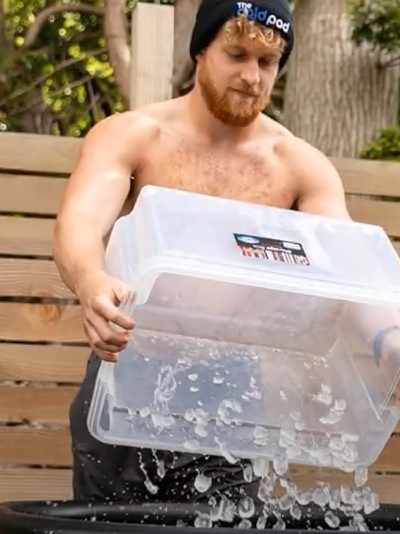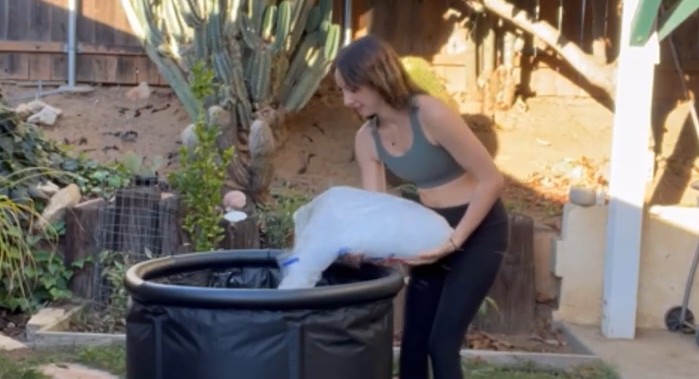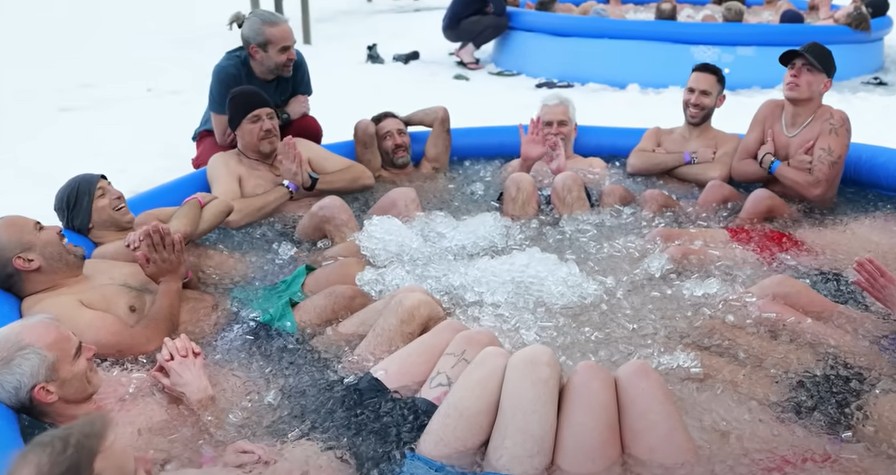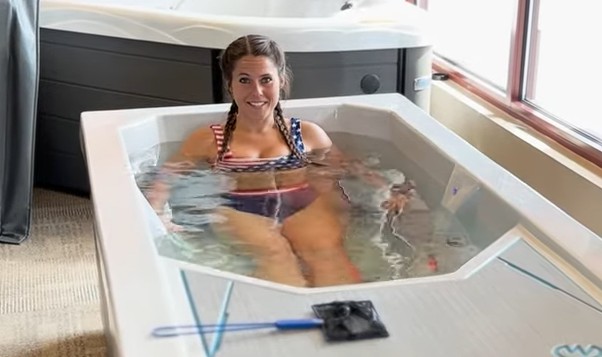Need help?
Unsure whether you need a bath or a plunge, portable or fixed, chiller or iced? Check out Sasha’s cold plunge vs ice bath article to answer all and get clarity on your cold immersion needs.

I never thought I’d become the guy who willingly submerges himself in a cold plunge tub every morning. I used to complain when the hot water ran out mid-shower.
But life has a funny way of throwing curveballs, and sometimes those curveballs come in the form of a 40-degree Fahrenheit cold plunge tub of water that changes everything.
It all started after a particularly grueling ultramarathon left me feeling like I’d been hit by a truck, then reversed over for good measure. A fellow runner, this crazy Norwegian dude named Lars, suggested I try a cold plunge tub to help with recovery.
I laughed it off at first, but the persistent ache in my muscles made me desperate enough to try anything.
That first plunge was intense. Every cell in my body screamed, begging me to get out of that frigid water.
But here’s what’s interesting – once I got out, I felt incredible.
My body hummed with energy I hadn’t felt in years. I felt reborn.
Cold plunging isn’t just a refreshing dip. It’s a practice that can improve your physical and mental health in profound ways.
Contents
- 1 The Science Behind the Chill
- 2 The Mental Game: Embracing Discomfort
- 3 Getting Started: Your Cold Plunge Journey
- 4 Common Pitfalls and How to Avoid Them
- 5 Adapting Cold Plunges to Your Lifestyle
- 6 Advanced Techniques: Taking It to the Next Level
- 7 Exercises to Enhance Your Cold Plunge Practice
- 8 The Long-Term Benefits of Cold Plunging
- 9 Customizing Your Cold Plunge Routine
- 10 The Social Aspect of Cold Plunging
- 11 Overcoming Mental Barriers
- 12 Integrating Cold Plunging into a Holistic Wellness Routine
- 13 The Environmental Impact of Cold Plunging
- 14 The Future of Cold Plunging
- 15 Frequently Asked Questions
- 15.1 What is a cold plunge?
- 15.2 How long should a cold plunge last?
- 15.3 Is cold plunging safe?
- 15.4 Can cold plunging help with weight loss?
- 15.5 How often should I do cold plunges?
- 15.6 Can I take a hot shower after a cold plunge?
- 15.7 Are there any risks associated with cold plunging?
- 15.8 Can cold plunging improve mental health?
- 15.9 What’s the difference between a cold plunge and an ice bath?
- 15.10 Can I do cold plunges if I’m pregnant?
- 16 Key Takeaways
The Science Behind the Chill
When you immerse yourself in cold water, your body goes into a controlled panic mode. Your blood vessels constrict, your heart rate increases, and your body starts pumping out a cocktail of hormones and neurotransmitters.
One of the key players here is norepinephrine. This hormone is responsible for that rush of alertness and focus you feel after a cold plunge.
It’s similar to the effects of caffeine, but without the jitters or crash.
Cold exposure also activates brown adipose tissue, or ‘brown fat.’ Unlike white fat, brown fat burns calories to generate heat. Regular cold exposure can increase the amount and activity of brown fat in your body, potentially aiding in weight management and metabolic health.
Research has shown that cold water immersion can reduce inflammation, boost the immune system, and improve cardiovascular health. Some studies suggest it could help with conditions ranging from depression to chronic pain.
The Mental Game: Embracing Discomfort
A cold plunge tub offers significant physical benefits, but they’re also a powerful tool for mental conditioning. Every time you step into that icy water, you face your fears head-on.
You train your mind to overcome the initial shock and panic, to push through discomfort and emerge stronger.
This daily exercise in mental toughness translates to every aspect of your life. That presentation you’re nervous about?
That difficult conversation you’ve been putting off?
After starting your day by voluntarily submerging yourself in near-freezing water, everything else seems a lot more manageable.
Getting Started: Your Cold Plunge Journey
If you’re intrigued by the idea of cold plunging but unsure where to start, don’t worry. I’ve got you covered.
First and foremost, start slow. Don’t try to be a hero and jump into a 33-degree tub right off the bat.
Begin with cool showers, gradually decreasing the temperature over time.
Once you’re comfortable with that, you can move on to actual cold plunges.
If you’re serious about making this a regular practice, consider investing in a top quality cold plunge tub. There are plenty of options out there, from high-tech tubs with precise temperature control to more portable ice baths.
>>Further Reading: Marcus’s list of top portable ice baths will lead you through the best-on-a-budget while Sasha’s list of best ice bath tubs shows the options for those that have become dedicated plungers.<<
Choose one that fits your budget and space constraints.
When you’re ready to take the plunge, start with short immersions – even 30 seconds can be useful. Focus on your breath, and try to stay calm and relaxed. As you get more comfortable, you can gradually increase the duration of your plunges.
Common Pitfalls and How to Avoid Them
Like any new practice, cold plunging comes with it’s own set of potential pitfalls. Here are a few to watch out for:
Overdoing it
More is not always better when it comes to cold plunging. Limit your plunges to a few minutes at most, and don’t do them more than once or twice a day.
Your body needs time to recover and adapt between sessions.
Ignoring your body
It’s crucial to listen to your body during cold plunges. If you start feeling numbness or severe pain, get out immediately.
Respect your body’s limits and don’t push yourself too hard, too fast.
Neglecting safety
Never plunge alone, especially when you’re just starting out. Have someone nearby in case of emergencies.
It’s also important to ensure your plunge area is safe and free from hazards.
Forgetting to warm up
After your plunge, it’s important to warm up gradually. Don’t jump straight into a hot shower – this can be a shock to your system.
Instead, gently warm up with light movement or by wrapping yourself in a warm towel or robe (our fave)
Adapting Cold Plunges to Your Lifestyle
The beauty of cold plunging comes from it’s flexibility. You can adapt it to fit your lifestyle and goals.
Here are a few ways to customize your practice:
Morning Plunges
Start your day with a quick dip to boost alertness and energy. A morning dip in your cold plunge tub can help you feel more awake and focused, setting a positive tone for the rest of your day.
Post-Workout Recovery
Use cold plunges after intense workouts to reduce muscle soreness and inflammation. This can help speed up your recovery and get you back to training sooner.
Stress Relief
End a stressful day with a cold plunge to reset your nervous system and improve sleep quality. The shock of cold water can help break the cycle of stress and anxiety, leaving you feeling calmer and more relaxed.
Contrast Therapy
Alternate between hot and cold exposures for enhanced benefits. This technique, known as contrast therapy, can improve circulation and provide a unique form of stimulation for your body.
Advanced Techniques: Taking It to the Next Level
Once you’ve mastered the basics of cold plunging, you might want to explore some more advanced techniques. Here are a few to consider:
Breath Work
Incorporate specific breathing techniques during your plunge to enhance the effects. Controlled breathing can help you stay calm and focused during the cold exposure, potentially increasing the benefits.
Meditation
Use your cold plunge tub time for mindfulness practice, focusing on the present moment. The intense sensations of cold water can serve as a powerful anchor for your attention, making it easier to enter a meditative state.
Ice Baths
For the truly adventurous, try adding ice to your cold plunge tub for an extra challenge. This can increase the intensity of the cold exposure and potentially boost the benefits.
Outdoor Plunging
If you’re lucky enough to live near a cold lake or river, try natural cold water immersion. Always ensure proper safety precautions are in place, including having a buddy system and knowing the water conditions.
Exercises to Enhance Your Cold Plunge Practice
To get the most out of your cold plunges, try incorporating these exercises:
Gradual Temperature Decrease
Each week, lower the temperature of your plunge by one degree. This gradual approach allows your body to adapt over time, potentially increasing your cold tolerance.
Duration Challenge
Slowly increase the time you spend in the cold water, aiming to add 5-10 seconds each session. This progressive overload principle can help you build mental and physical resilience.
Mindfulness Practice
During your plunge, focus on different parts of your body, noticing the sensations without judgment. This can enhance your body awareness and help you stay present during the challenging experience.
Post-Plunge Journaling
Keep a record of how you feel before and after each plunge to track your progress and insights. This can help you identify patterns and improve your practice over time.
The Long-Term Benefits of Cold Plunging
While the immediate effects of cold plunging are often what draw people in, the long-term benefits can be truly life-changing. Here’s what you might experience with consistent practice:
Improved Stress Resilience
Regular exposure to controlled stress (like cold water) can make you more resilient to other forms of stress in your life. You may find yourself handling challenging situations with more ease and grace.
Enhanced Immune Function
Some studies suggest that regular cold exposure can boost your immune system, potentially leading to fewer illnesses and faster recovery times when you do get sick.
Better Sleep Quality
Many cold plungers report improved sleep quality, possibly because of the regulation of stress hormones and the calming effect on the nervous system.
Increased Energy and Vitality
The invigorating effects of cold plunging can lead to increased energy levels throughout the day. You might find yourself relying less on caffeine and feeling more naturally alert.
Improved Mood and Mental Health
Cold exposure has been linked to the release of endorphins and other mood-boosting neurotransmitters. Regular practice may help reduce symptoms of depression and anxiety.

Customizing Your Cold Plunge Routine
As you become more experienced with cold plunging, you’ll likely want to tailor your routine to your specific needs and goals. Here are some ways to customize your practice:
Timing
Experiment with different times of day for your plunges. Some people prefer morning plunges for an energizing start to the day, while others find evening plunges help them unwind and prepare for sleep.
Frequency
Determine the optimal frequency for your plunges. Some people benefit from daily plunges, while others find that 2-3 times per week is sufficient.
Duration
Find the sweet spot for your plunge duration. This will likely change over time as your body adapts to the cold.
Listen to your body and adjust accordingly.
Temperature
Play with different water temperatures to find what works best for you. Remember, colder isn’t always better – find a temperature that challenges you without being overwhelming.
Complementary Practices
Consider combining your cold plunges with other wellness practices like meditation, yoga, or breathwork for enhanced benefits.
The Social Aspect of Cold Plunging

While cold plunging can be a solitary practice, there’s also a growing community of cold plunge tub enthusiasts. Connecting with others who share your interest can provide motivation, support, and a sense of camaraderie.
Here are some ways to engage with the cold plunge community:
Join Local Groups
Look for local cold plunge or cold water swimming groups in your area. These groups often organize regular meetups and can be a great source of information and support.
Online Communities
Participate in online forums and social media groups dedicated to cold plunging. These platforms can be excellent resources for tips, advice, and inspiration.
Attend Events
Keep an eye out for cold plunge events or workshops in your area. These can be great opportunities to learn from experts and connect with fellow enthusiasts.
Start Your Own Group
If you can’t find a local group, consider starting your own. Invite friends or colleagues to join you in your cold plunge practice.
Overcoming Mental Barriers
For many people, the biggest obstacle to starting a cold plunge practice isn’t physical – it’s mental. Here are some strategies to help you overcome those mental barriers:
Start Small
Remember, you don’t have to jump into a freezing lake on day one. Start with short exposures to cool (not cold) water and gradually work your way up.
Focus on the Benefits
When you’re struggling to motivate yourself, remind yourself of the many benefits you’ll experience. Visualize how good you’ll feel after the plunge.
Use Positive Self-Talk
Replace negative thoughts (“This is going to be terrible”) with positive affirmations (“I am strong and capable of handling this challenge”).
Celebrate Your Achievements
Acknowledge and celebrate each milestone in your cold plunge journey, no matter how small. This positive reinforcement can help build momentum and motivation.
Integrating Cold Plunging into a Holistic Wellness Routine
While cold plunging can be incredibly beneficial on it’s own, it’s even more powerful when integrated into a comprehensive wellness routine. Here’s how you can combine cold plunging with other practices for optimal health:
Nutrition
A nutrient-dense diet can support your body’s ability to adapt to cold stress. Focus on whole foods, plenty of vegetables, and adequate protein intake.
Exercise
Regular physical activity complements cold plunging well. Both practices challenge your body and can lead to improved resilience and overall health.
Sleep
Prioritize good sleep hygiene to support your body’s recovery processes. Cold plunging can actually help improve sleep quality for many people.
Stress Management
Combine cold plunging with other stress-reduction techniques like meditation, deep breathing, or journaling for a comprehensive approach to stress management.
Hydration
Proper hydration is crucial when practicing cold plunging. Ensure you’re drinking plenty of water throughout the day.
The Environmental Impact of Cold Plunging
As with any practice, it’s important to consider the environmental impact of cold plunging. Here are some ways to make your practice more eco-friendly:
Energy-Efficient Tubs
If you’re using a cold plunge tub at home, choose an energy-efficient model to minimize electricity usage.
Natural Water Sources
When possible and safe, consider using natural water sources for your cold plunges. This eliminates the need for electricity and can provide a more immersive nature experience.
Water Conservation
If using a tub, change the water less frequently (while still maintaining proper hygiene) to conserve water.
Eco-Friendly Products
Use environmentally friendly cleaning products to maintain your tub or any equipment you use for cold plunging.
The Future of Cold Plunging
As interest in cold plunging continues to grow, we’re likely to see some exciting developments in the field. Here are some trends to watch:
Advanced Technology
We may see a more sophisticated cold plunge tub with features like precise temperature control, built-in timers, and even biometric monitoring.
Scientific Research
As cold plunging gains popularity, we can expect to see more scientific studies exploring it’s benefits and optimal protocols.
Integration with Healthcare
Cold therapy may become more widely recognized and integrated into mainstream healthcare practices for various conditions.
Virtual Reality Integration
Some companies are exploring ways to combine cold plunging with virtual reality experiences to enhance the mental aspects of the practice.
Frequently Asked Questions
What is a cold plunge?
A cold plunge involves immersing your body in cold water, typically between 50-59°F (10-15°C), for a short period of time. This practice is believed to offer various health benefits.
How long should a cold plunge last?
For beginners, start with 30 seconds to 1 minute. As you build tolerance, you can gradually increase to 2-3 minutes.
Always listen to your body and don’t overdo it.
Is cold plunging safe?
Cold plunging is generally safe for healthy people when done properly. However, those with certain health conditions should ask a doctor before starting.
Never plunge alone, especially as a beginner.
Can cold plunging help with weight loss?
While cold exposure can increase calorie burn by activating brown fat, it’s not a magic solution for weight loss. It’s most effective when combined with a healthy diet and regular exercise.
How often should I do cold plunges?
This varies by individual, but many people benefit from 2-3 cold plunges per week. Some enthusiasts practice daily, but it’s important to give your body time to recover between sessions.
Can I take a hot shower after a cold plunge?
It’s best to warm up gradually after a cold plunge. Light exercise or wrapping yourself in a warm towel is preferable to an immediate hot shower, which can be a shock to your system.
Are there any risks associated with cold plunging?
Potential risks include hypothermia if done improperly, shock to the system for people who have heart conditions, and skin irritation. Always start gradually and ask a healthcare professional if you have any concerns.
Can cold plunging improve mental health?
Many people report improved mood and reduced symptoms of anxiety and depression with regular cold plunging. The practice can boost endorphins and may help regulate stress hormones.
What’s the difference between a cold plunge and an ice bath?
It’s best to read Sasha’s post on this one for the definitive answer.
Can I do cold plunges if I’m pregnant?
Pregnant women should ask with their healthcare provider before starting any new wellness practice, including cold plunging. Generally, extreme temperature changes are not recommended during pregnancy.
Key Takeaways
- Cold plunging offers a wide range of physical and mental health benefits, from reducing inflammation to boosting mental resilience.
- Start slow and gradually build up your tolerance to cold water.
- Invest in a good quality cold plunge tub for regular practice.
- Listen to your body and respect it’s limits.
- Customize your cold plunge practice to fit your lifestyle and goals.
- Explore advanced techniques and exercises to enhance your practice.
- Cold plunging is a transformative practice that can change your approach to discomfort and challenge in all areas of life.
This website may contain affiliate links. As an affiliate, we may earn a commission from qualifying purchases at no additional cost to you.

